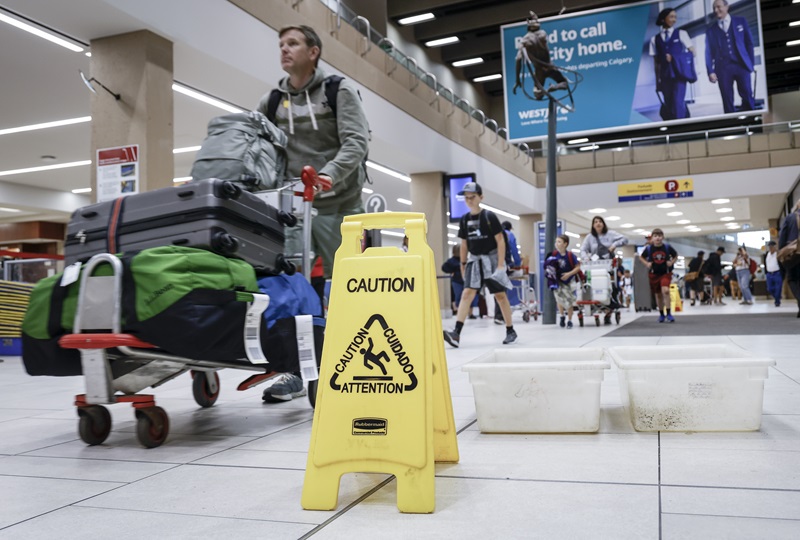Calgary hailstorm ranks Canada’s 2nd-worst NatCat of all time

Calgary’s hailstorm in early August caused nearly $2.8 billion in insured damage, eclipsing the previous record for a single hailstorm ($1.2 billion) set in 2020.
“This hailstorm is the second-costliest event in Canada’s history, following the 2016 Fort McMurray wildfire,” Insurance Bureau of Canada said in a release, citing data from Catastrophe Indices and Quantification Inc. (CatIQ). “With yet another record-setting summer for insured losses due to severe weather, these losses will place pressure on insurance premiums moving forward.”
On August 5, 2024, severe thunderstorms developed over southern Alberta and moved east, producing significant and damaging hail, strong winds, heavy rain and localized flooding in parts of Calgary. Environment and Climate Change Canada said it received multiple reports of hailstones the size of chicken eggs damaging homes and vehicles. The city’s airport sustained significant damage.
“With the Jasper wildfire causing over $880 million in insured damage, severe weather has cost insurers over $3.6 billion in Alberta this summer alone,” IBC says. “Canada’s insurers have also been simultaneously supporting customers impacted by the July Toronto floods and flooding across Quebec.”
Canada has seen the most damaging summer on record due to severe weather, with approximately 228,000 insurance claims related to four major catastrophic weather events — a 406% increase compared to the previous 20-year average, as IBC observes. Ontario’s flood caused insured damage of about $940 million, bringing the total for NatCat damage this year up to $4.6 billion, with official insured loss counts from Quebec not available yet.
Hard market in property
In an appearance at the Scotiabank Financial Summit on Sept.5, Intact Financial Corporation CEO Charles Brindamour agreed with a panel moderator that the 2024 Q3 catastrophes will “absolutely” lead to a hard market in personal lines over the “near to mid-term.”
“I think the pressure we’re seeing this summer will contribute to that,” Brindamour said. “I think the thing to look at in personal lines is the industry’s performance. If you look at the industry’s performance in personal lines, you’re likely to get a sense of where rates are headed.
In other news: P&C industry urges changes to adjusters licensing
“And if you do that, and you look at Q1 of 2023 — Q2 is not available for the industry— you’ll see that the industry [combined operating ratio] in personal lines is running north of 100%, and I think it’ll be worse than that if you look at Q2 and Q3. And for me, that points to ongoing firm, hard pricing environment.”
Brindamour described the first three weeks of the third quarter as “very intense,” saying the company is processing 50,000 claims from natural disasters in about a month. The company issued guidance previously this month, estimating the company will be paying out approximately $1.1 billion in claims for all of the NatCat events combined. “We think it’s one-in-30-year type [of event],” he said of the close timing of all the storms together.
More investment in resilience required
IBC notes Alberta NatCats have dominated Canada’s Top 10 list over the past decade.
“Alberta has experienced five of the Top 10 costliest disasters in Canadian history, all of which have occurred since 2016, placing significant strains on home, business, and auto insurance premiums,” IBC commented. “The Calgary area in particular has seen several catastrophic hailstorms in recent years, including the 2020 and 2021 hailstorms that caused over $1.2 billion and $700 million in insured damage, respectively.
“Given these trends, it’s critical that governments re-invest in programs such as the municipal Resilient Roofing Rebate Program that help increase the resilience of homes and businesses to future hail events.”
After the 2020 hailstorm event, the City of Calgary [alongside the Institute for Catastrophic Loss Reduction (ICLR)] set aside $3.25 million for the Resilient Roofing incentive program. The rebate provided up to $3,000 to homeowners wishing to install Class 4 impact-resistant roof cover, ICLR managing director Glenn McGillivray told CU.
But the city discontinued the program after its funding ran out, despite the program being oversubscribed.
Insurers are calling on governments of all levels and political stripes to invest more in building resiliency to climate change.
“Insurers paid out more in claims for this one hail event than the federal government has invested on climate adaptation over the past decade,” said Craig Stewart, IBC’s vice president of climate change and federal issues.
“The surging frequency and severity of floods, wildfires, hail and windstorms, represent an escalating threat to lives and property across Canada, yet governments have been vexingly slow to respond and have yet to enact the kinds of meaningful measures that would help Canadians prepare,” he said.
“Improved hail alerting that urges people to park their cars safely and stay indoors, improved building codes that incorporate hail resistant siding and roofing in high-risk areas, provincial and federal retrofit programs must be enacted to help families and businesses build resilience moving forward.”
– With files from Jason Contant
An aviation expert says airfares may rise in the immediate aftermath of a hailstorm that tore through Calgary on Tuesday evening, damaging WestJet planes. Travellers manoeuvre around buckets catching leaks as repairs are underway at the Calgary International Airport after parts of its domestic terminal building were closed late Monday due to damage caused by hail and heavy rainfall, in Calgary, Tuesday, Aug. 6, 2024. THE CANADIAN PRESS/Jeff McIntosh







